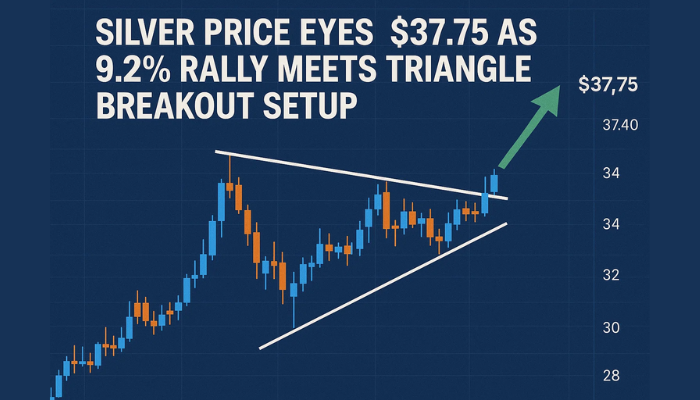Prices Forecast: Technical Analysis
For the daily forecast, Silver is expected to close around $37.12, with a potential range between $36.59 and $37.58. The weekly forecast suggests a closing price near $37.25, with a range from $36.71 to $37.37. The RSI at 64.42 indicates a bullish momentum, suggesting that Silver might continue its upward trend. The ATR of 0.5836 reflects moderate volatility, which could lead to price fluctuations within the predicted range. The MACD histogram shows a positive value, supporting the bullish outlook. However, the ADX at 16.49 suggests a weak trend, indicating that while the price might rise, the strength of the trend is not robust. The economic calendar shows no significant events that might impact Silver directly, allowing technical indicators to play a more prominent role in price movements.
Fundamental Overview and Analysis
Silver has shown a steady upward trend recently, driven by increased industrial demand and investor interest as a hedge against inflation. The metal’s value is influenced by its dual role as both an industrial commodity and a precious metal. Investor sentiment remains positive, with many viewing Silver as undervalued compared to Gold. Opportunities for growth include its use in renewable energy technologies and electronics. However, challenges such as market volatility and potential regulatory changes could pose risks. Currently, Silver appears fairly priced, with room for growth if industrial demand continues to rise. The asset’s performance is closely tied to economic conditions, particularly in manufacturing sectors, which could impact its valuation.
Outlook for Silver
The future outlook for Silver remains positive, with expectations of continued demand from industrial sectors. Historical price movements show a gradual upward trend, supported by moderate volatility. Key factors influencing Silver’s price include economic conditions, particularly in manufacturing and technology sectors, and potential regulatory changes. In the short term (1 to 6 months), Silver is likely to see moderate gains, with prices potentially reaching the upper resistance levels. Long-term forecasts (1 to 5 years) suggest continued growth, driven by technological advancements and increased industrial use. External factors such as geopolitical tensions or market crashes could significantly impact Silver’s price, but the overall trend remains bullish.
Technical Analysis
Current Price Overview: The current price of Silver is $37.12, slightly above the previous close of $37.09. Over the last 24 hours, Silver has shown a bullish trend with moderate volatility, as indicated by the ATR. Support and Resistance Levels: Key support levels are at $36.92, $36.71, and $36.59, while resistance levels are at $37.25, $37.37, and $37.58. Silver is trading above the pivot point of $37.04, suggesting a bullish sentiment. Technical Indicators Analysis: The RSI at 64.42 indicates a bullish trend, while the ATR suggests moderate volatility. The ADX at 16.49 shows a weak trend strength. The 50-day SMA and 200-day EMA do not show a crossover, indicating a stable trend. Market Sentiment & Outlook: Sentiment is currently bullish, supported by the price action above the pivot, a positive RSI, and stable moving averages. However, the weak ADX suggests caution as the trend strength is not robust.
Forecasting Returns: $1,000 Across Market Conditions
Investing $1,000 in Silver could yield different returns based on market conditions. In a Bullish Breakout scenario, a 10% price increase could raise the investment to approximately $1,100. In a Sideways Range, the investment might remain around $1,000, reflecting stability. In a Bearish Dip, a 5% decrease could reduce the investment to about $950. These scenarios highlight the importance of market conditions in investment outcomes. Investors should consider their risk tolerance and market outlook before investing. Diversifying investments and staying informed about market trends can help mitigate risks and optimize returns.
| Scenario | Price Change | Value After 1 Month |
|---|---|---|
| Bullish Breakout | +10% to ~$40.83 | ~$1,100 |
| Sideways Range | 0% to ~$37.12 | ~$1,000 |
| Bearish Dip | -5% to ~$35.26 | ~$950 |
FAQs
What are the predicted price forecasts for the asset?
The daily forecast for Silver suggests a closing price around $37.12, with a range between $36.59 and $37.58. The weekly forecast indicates a closing price near $37.25, with a range from $36.71 to $37.37.
What are the key support and resistance levels for the asset?
Key support levels for Silver are at $36.92, $36.71, and $36.59. Resistance levels are at $37.25, $37.37, and $37.58. The pivot point is at $37.04, and Silver is currently trading above it, indicating a bullish sentiment.
What are the main factors influencing the asset’s price?
Silver’s price is influenced by industrial demand, investor sentiment, and its role as a hedge against inflation. Economic conditions, particularly in manufacturing sectors, and potential regulatory changes also play significant roles.
What is the outlook for the asset in the next 1 to 6 months?
In the short term, Silver is expected to see moderate gains, with prices potentially reaching upper resistance levels. The outlook remains positive, driven by industrial demand and technological advancements, despite potential market volatility.
Disclaimer
In conclusion, while the analysis provides a structured outlook on the asset’s potential price movements, it is essential to remember that financial markets are inherently unpredictable. Conducting thorough research and staying informed about market trends and economic indicators is crucial for making informed investment decisions.



